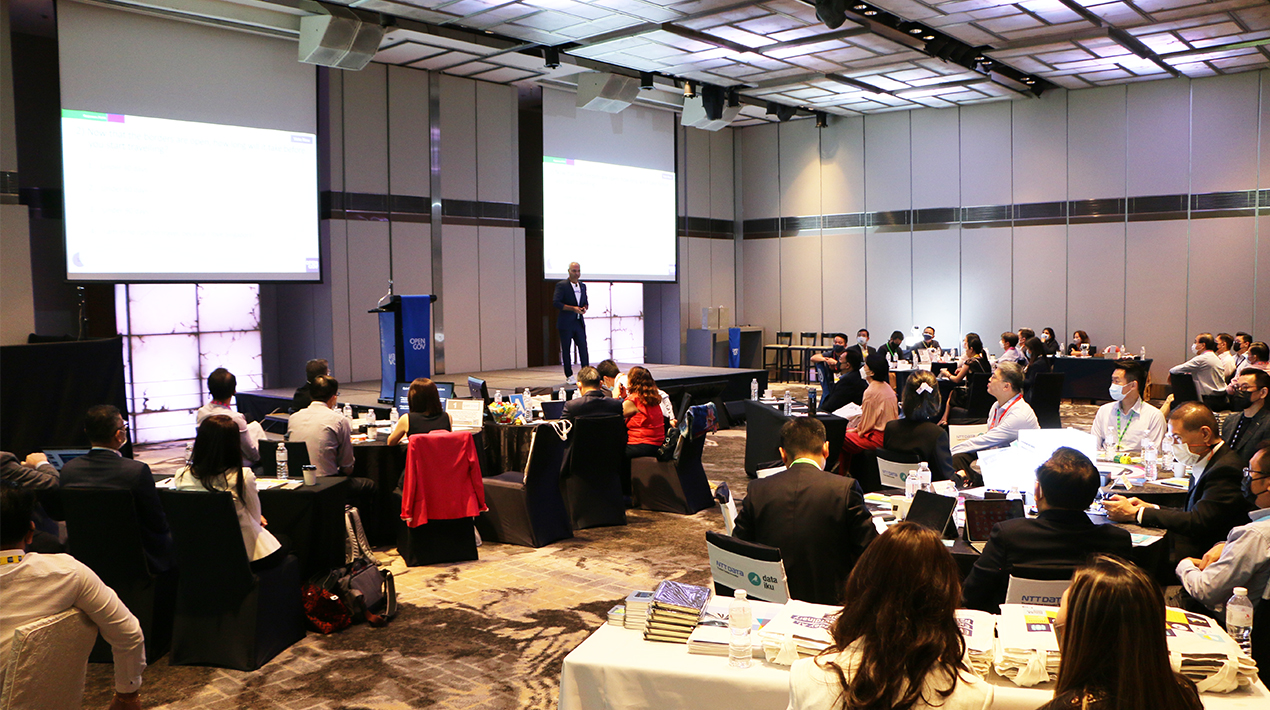
“In this new normal, the countries which are united, disciplined and put in place sensible safeguards will be able to reopen their economies, reconnect to the rest of the world, grow, and prosper. Singapore will be among these countries – more confident and resilient than before and toughened by what we have overcome together as one nation.” Prime Minister, Lee Hsien Loong.
These words of cautious optimism by PM Lee seek to prepare Singaporeans for life beyond COVID-19. He outlined the future beautifully saying, “Singapore’s priority is to get through this pandemic and position ourselves strongly for the future”.
As all prepare to return to new “normalcy”, what does this future look like?
- What and how should everyone be preparing for the “new normal”?
- Is everyone ready to embrace this next normal?
- Would the citizens’ expectations change?
- What kind of new citizen-facing touchpoints would have to be invented to best serve future needs?
How technology will be supporting the reshaping of the world with lessons learnt from COVID-19?
Singapore OpenGov Leadership Forum 2022, Day 1, was held on 17 May 2022 at Singapore Marriott Tang Plaza Hotel. It convened digital leaders from the Singapore public sector and financial services industry to discuss, deliberate, share and plan for the next phase of transformation.
Humanising the digital transformation

Mohit Sagar, Group Managing Director, and Editor-in-Chief, OpenGov Asia, kicked off the session with his opening address.
COVID-19 changed people’s realities and has caused a significant paradigm shift in digital thinking. For one, working from home became accepted as part of the work culture and going completely back to an office is no longer an option. “People want the hybrid model,” Mohit stresses.
Compounding the current pandemic related issues are climate challenges. “Climate change affects everything from geopolitics to economies to migration,” Mohit opines. “It shapes cities, life expectancies and all life forms.”
This dual problem exacerbates the demands of a rapidly changing world and heightens the need to harness technology to solve them.
“We have been coping the past two years with ‘band-aid’ technology,” Mohit feels. “These ad hoc solutions and platforms that were used during the pandemic need to be scaled up, taken forward and mainstreamed.”
Technology has the potential to elevate the quality of life, improve healthcare and benefit everyone in all spheres and stages of life.
However, the conundrum is: does the existing technology in organisations allow them to cope with the rapid changes in the new normal? Are organisations able to truly transform?
There are pockets of excellence, but they must be scaled up. Issues faced by persons with disabilities – autism spectrum, down syndrome, physical challenges – can be addressed by technology to enrich their lives and allow them to live up to their potential and contribute to the nation.
Technology can help to create an inclusive and sustainable society. The world is changing rapidly and the ways people are utilising technology to solve problems are keeping pace.
Walkme is accelerating digital adoption to deliver on value; Dataiku solutions ensure the AI transformation aligns with strategic goals and is meaningful for the organisation; SAS with its AIOT solutions has helped the state of Rajasthan in India to manage natural resources such as water more efficiently; Neo4J offers graph technology that contributes to COVID-19 research and Boomi is developing technology that can help with the American Cancer Society.
To cope with the new demands of the citizens, organisations need to leverage data, embrace AI and pivot towards automation. “These trends are here to stay,” Mohit states emphatically.
He encouraged delegates to look for partners who are experts in their field of work who can help organisations keep their glass full so that they can focus on their business objectives.
Adopting technology to smoothen the flow of data
 Eyung Lim, Director, Government Digital Services (Digital Design & Development), Government Technology Agency of Singapore (GovTech) spoke on a Smart Nation journey.
Eyung Lim, Director, Government Digital Services (Digital Design & Development), Government Technology Agency of Singapore (GovTech) spoke on a Smart Nation journey.
“There are multi-dimensional needs in the government,” Eyung begins. To illustrate, he starts with MaskGoWhere and the development of the mask distribution process.
The short turnaround time and the changing operations due to the shipment and packing of the masks was a significant challenge that needed a major shift in design. They needed to create an operational process that had zero queues at the collection points.
The initial challenge was the fact that “there was no structural data for them to work from,” Eyung shares, emphasising that they had to work with PDFs and images.
The eventual solution was a Do it yourself (DIY) approach where the operation personnel update the information.
The most single yet important factor in service delivery is a smooth flow of data and information for both Inside-Outside Communications and Outside-In Communications.
There are two key principles underlying the applications of the government:
- Repeatability
- Scalability
Eyung shared that Singapore has more than 3000 digital service touchpoints and explained how the Whole of Government Application Analytics helps to support the different touchpoints. A single tracking script is used to collect and track data across all the agencies.

Eyung emphasises the importance of automation in improving the usability and accessibility of the 3000 touchpoints in the government by creating consolidated report delivery and presentation.
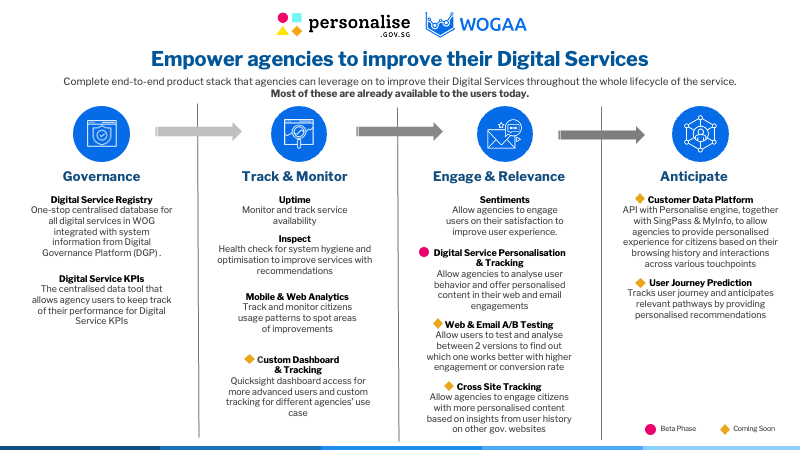
With the tech stack tool, the GovTech can empower agencies to improve their digital services in two ways:
- Continuous monitoring and improvements
WOGAA, one of the business-facing sites, has been able to proactively conduct self-health checks as well as identify its Applicants’ pain points, thus giving a lead on how the system is to be improved further. WOGAA also enables the business team to benchmark itself against all other gov websites/web-app in terms of satisfaction and learn from the better ones.
- COVID-19/Real-Time Operation
WOGAA has supported several COVID-19 Initiatives e.g., MaskGoWhere, SupportGoWhere, FluGoWhere and VoteQ.
Inclusivity: Added Multilingual support for 4 languages
Usability: On top of what was reported in the WOGAA inspection, it added navigation routing to the nearest CCs/RCs via OneMap integration
Data Accuracy: Included postal codes that were miss out in the earlier dataset
In closing, Eyung mentions the importance of the tech stack in smoothening operations and enabling better access to services. When harnessed appropriately, it can help organisations solves problems seamlessly and effectively.
Mitigating fraud through analytics

Shaun Barry, Global Director – Fraud & Security, Intelligence, SAS spoke next about trends in fraud detection and the integrity of government.
The central question is how organisations can continue with vigilance to maintain their integrity. Essentially, the government has not kept up their defence as much as the banks have – that is where the fraudsters have chosen to focus their energies. It is a trend that the world has seen over the past few years.
The government has been pouring resources to help businesses and individuals to stimulate the economy and keep citizens safe during the pandemic. As a result, attacks by fraudsters have accelerated.
The combination of digital transformation and the outpouring of resources has made it a criminal’s paradise.
In response to the rising challenge, Shaun shares 4 ways governments are using analytics to stop
- Verifying Digital Identities: Understanding when someone presents one looking at the metadata and the information about the device.
- Enforce integrity in real-time: Being able to analyse the structured and unstructured information which can be applied to managing risk
- Spot emerging trends and detect signals: In the US, analytics is used by prosecutors to help them prepare for their cases.
- Perform continuous monitoring for internal controls
In conclusion, Shaun believes that the fraudsters will continue to innovate regardless of how safe people may feel. He encourages delegates to reach out to him to understand how analytics can help with fraud detection and risk management.
Elevating services through Graph Data Technology

Ryan Sim, Director – Public Sector, Neo4j spoke next about the importance of data in context.
“Data can only make sense if there is context, context can only happen if datasets are interconnected, enriched with meaning so that organisations can reason about the underlying data and use it confidently for complex decision making,” Ryan claims.
About everything we do today will end up in a database somewhere, Ryan asserts. Relationships are created all the time, from the time one leaves the house to head to another venue, a relationship is created. That is what Ryan observes in Neo4j Meta-universe – representations of nodes and relationships.
Connections enhance context and are as valuable as the data itself. Data relationships create context and interrelationships create structure. Graphs add context to data through relationships and “data in context equates to knowledge”.
Analysts have made bold predictions as to the increased use of graph technology across organisations, with incredibly fast growth rates. Gartner suggests that by 2025 the increased use will go to 80% of all data and analytics innovations, up from 10%.
“What is also worth noting,” says Ryan, “is for the first time in 40 years we have a new database language – everyone is familiar with SQL.”
In the next few years, the industry will consolidate graph query standards around GQL. This is important for departments investing in a graph data platform, that it that they use a platform that has a long-term future built on open standards and preferably already use a query language that offers an easy pathway to GQL.
“How do we go from collecting data to connecting data?” Ryan asks.
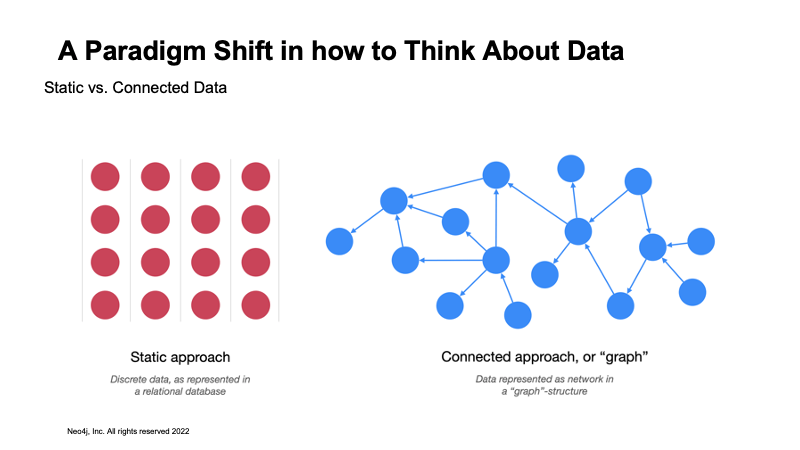
It would first require a paradigm shift in how to think about data – from static, discrete data to connected data. With Graph Data, organisations can see a cross-silo view of department data – the graph complementing existing technologies and building a bridge of relationships.
Graphs are not new, Ryan remarks. They are already used in a lot of situations today among leading companies. One may not realise it, but people might be interacting with a graph database if they are banking, browsing a shopping website or booking a flight ticket.
Graphs are extensively used in a wide variety of use cases — fraud detection, supply chain management, customer experience, compliance and privacy management, personalisation and recommendations, medicine research and cyber security.
Most prominently, graphs have been used to trace, isolate and vaccinate individuals in the fight against COVID-19.
In conclusion, Ryan shares that Neo4j is seeing dramatic growth in the adoption of graph technology currently. He encourages delegates to consider potential business problems/use cases where Connected Data (Graph Technology) may be useful and relevant.
For those that are interested, they can contact Neo4j for a Discovery Workshop and leverage the GovTech Bulk Tender.
Polling Results for the Morning Session
Throughout the session, delegates were polled on different topics.
In the first poll, delegates were asked about the item that will have the bulk of their budget allocation in 2022 –2023. Most of the delegates (432%) have a bulk of their budget allocation in the digitalisation of processes to deliver better or ‘Smart’ services. The remaining selected enhancing or adopting AI and Analytics for improving outcomes through forecasting, prediction and optimisation (21%), improving integrity and governance whilst reducing inefficiency (16%), embracing cloud technology, be it public or private (11%), leveraging IoT to improve processes and productivity (5%), followed by data-driven initiatives such as Big Data/Data Lake (5%)
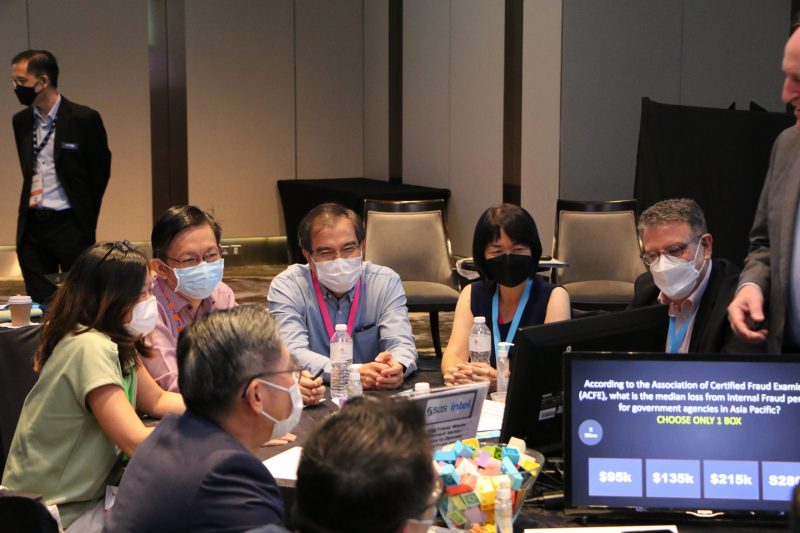 The next question inquired what the main challenge was in their data strategy. The majority (48%) found the lack of data culture/literacy/skill across employees challenging. The others opted for data governance, data privacy and security concerns (27%), followed by missing an overall strategy that crosses departments and teams (15%) and the lack of a centralised tool for sharing and collaboration (9%).
The next question inquired what the main challenge was in their data strategy. The majority (48%) found the lack of data culture/literacy/skill across employees challenging. The others opted for data governance, data privacy and security concerns (27%), followed by missing an overall strategy that crosses departments and teams (15%) and the lack of a centralised tool for sharing and collaboration (9%).
When asked about the delegates’ key concerns in the consideration to move to cloud, over half (54%) were concerned about security and governance. The others consider the need to re-skill talent (26%), operational costs (14%) and vendor lock-in (6%)as their primary challenges.
On questioned about their biggest challenge in digitalisation and cloud migration, under a third (32%) found people and skillset the most demanding. This was followed by legacy infrastructure (23%), data classification/data sovereignty/data residency concern (18%), security and compliance risks (14%), executive support/top management strategy (9%) and budget (5%).
The next poll asked delegates about their key priorities to enhance the service experience of citizens/ customers. Just over a third (34%) identified unifying channels, tools and customer context into a single view as the key priority and another 29% opted for leveraging analytics to personalise customer interactions. The remaining delegates either chose improving internal collaboration across teams ad agencies (22%), increasing the adoption and usage of self-service & AI-powered bots (12%) or implementing messaging as part of their communication channels (2%)
When asked about the top analytic adoption challenge in their organisation, well over half (58%) expressed that data quality and accuracy are the top concerns. This was followed by a lack of talent and training (22%), tools that are too complex and difficult (14%) and limited access to analytics (6%).
On the current usage of Graph Database in their department, half of the delegates (50%) use it to a limited extent and are in the initial phase of exploring how graphs can be of value. Another section was split between using it on a small scale or having some understanding of how graphs work (23%) and using it in several projects but not at a production level but are familiar with graphs (23%). The remainder use graph at an enterprise level and are curious to find out more about scalability, and distributed (advanced users/clients) (5%).
The final poll for the day asked delegates about the main motivator that is driving digital transformation. Most (45%) see a growing need to maximise value/insights from an increasing amount of data assets. Others are motivated by the desire to speed up our time-to-market to fully capitalise on business opportunities or to serve citizens better (26%), the improved capability to manage the increasing amount of data at the edge locations while ensuring security and compliance (16%) and to provide a consistent and seamless cloud-everywhere experience across a distributed organisation (13%).
Driving business outcomes by developing AI Maturity

Nicholas Eng, Solutions Engineer, Dataiku spoke next about how organisations can advance along the AI maturity curve.
“The challenge is not the tech,” Nicholas claims. “Dataiku’s core belief is that technology accounts for 5% of AI failures, while process and culture for 95%!”
“Why assess the AI Maturity?” Nicholas asks. There are three reasons for that:
Benchmarking: Place yourself on the potential growth curve toward mastery of leveraging AI — identify if your AI is acting as a utility, a business enabler, or a business driver, and where you stand vs. your competitors
Strategic Planning: Strategise the internal organisational steps you should take to be confident
Communicating the Vision: Communicate to management where you stand and how far you have to travel, and at what rate you can expect it
There are six main dimensions an organisation must deliver on to evolve from one maturity phase to another. While no one “right” operating model works for every company, there are six components that should be addressed to shape the appropriate operating model: managing supply & demand, favour AI adoption and AI transformation of the whole group, agility & robustness, futureproofing / sustainability
Dataiku categorises AI maturity in 5 stages: Explore, Experiment, Establish, Expand, Embed
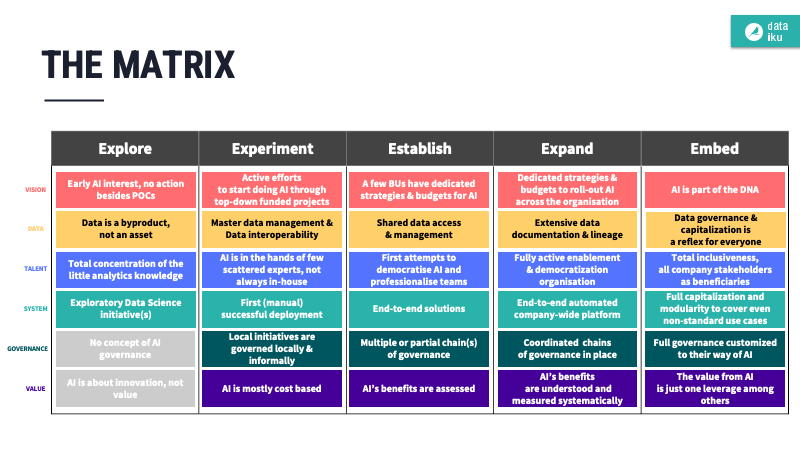
For Nicholas, every stage comes with its own set of challenges and achievements
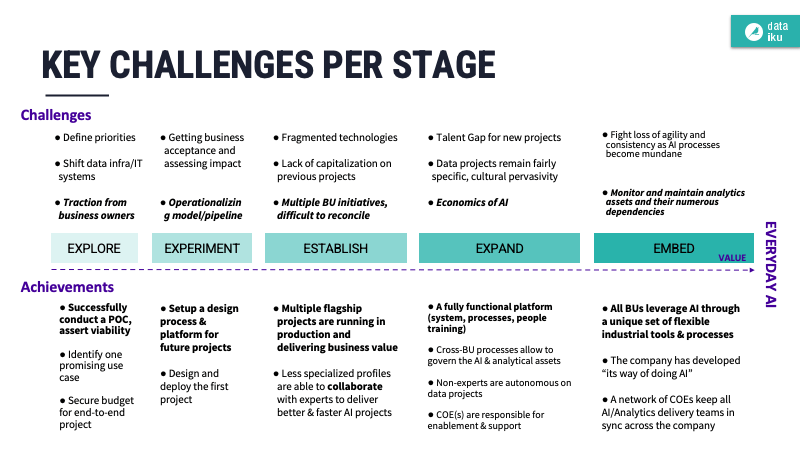
Nicholas shared the use case of a Telco company. They started small, broke down silos and have now achieved remarkable scale. They had a vision of pervasive self-service analytics and ML (Machine Learning) workbench, to increase from 10 to 500 projects, and 50 to 200+ users.
Closing his presentation, He emphasised the tremendous benefits to be reaped in AI adoption and encouraged delegates to reach out to him if they have queries or would like to get started on the AI adoption journey.
Fireside Chat: Drive User Adoption to Transform Digital Outcomes
 Following the presentations, Mohit Sagar, Group Managing Director, and Editor-in-Chief, OpenGov Asia and Ang Lee Yen, Asia Sales Leader, WalkMe sat down for a fireside chat to discuss strategies to drive user adoption to transform digital outcomes.
Following the presentations, Mohit Sagar, Group Managing Director, and Editor-in-Chief, OpenGov Asia and Ang Lee Yen, Asia Sales Leader, WalkMe sat down for a fireside chat to discuss strategies to drive user adoption to transform digital outcomes.
Lee Yen began by sharing that WalkMe is a digital adoption platform, putting the user experience at the heart of decision-making. While the idea for WalkMe was first born in Singapore, WalkMe in the US opted for IPO last year and the Singapore office opened only two weeks ago.
Mohit remarked that there is a lot of pain in digital adoption and was curious about Lee Yen’s opinion about the biggest problem that people faced.
“Every year, organisations spend almost US$ 600 billion on software implementation,” Lee Yen asserts. “However, 70% of the organisations are not getting the RoI from their digital transformation projects.”
The primary reason, she pointed out, is that the user is not placed at the heart of digital transformation projects. Many organisations focus on rolling out the technology, but neglect making digital adoption intuitive for the user. “Technology has to be easy for people to use,” she firmly believes.
Mohit concurred that digital adoption is an important aspect to consider in digital transformation projects. He was keen to know how organisations use WalkMe in their digital transformation.
Lee Yen shared that organisations excel when they look beyond the technology to consider the user, business case and business outcomes. The trend for Singapore is a move towards becoming a digital nation where self-service is at the centre.
GovTech has set aside a digital readiness blueprint that seeks to be more inclusive. Digital adoption can help with the onboarding process. For example, when COVID-19 struck, many educational institutions had to pivot to e-learning even though there may be teachers, parents and children who may not be digitally savvy.
In concluding the session, Lee Yen opines that WalkMe is a product for employees and customers. Saving time and automating processes for employees can turn into smoother services for customers, she believes. Digital adoption can help to ensure that digital transformation projects that organisations embark on yield the impact that was intended.
Fireside Chat: Importance of Data Culture and Literacy
 Following the presentations, Mohit Sagar, Group Managing Director, and Editor-in-Chief, OpenGov Asia and Celine Le Cotonnec, Chief Data Innovation Officer, Bank of Singapore discussed the critical importance of data literacy in implementing a data-driven culture.
Following the presentations, Mohit Sagar, Group Managing Director, and Editor-in-Chief, OpenGov Asia and Celine Le Cotonnec, Chief Data Innovation Officer, Bank of Singapore discussed the critical importance of data literacy in implementing a data-driven culture.
“Data is oil, yet it is not refined, and it is never clean,” Mohit remarks. Mohit is curious to know what Celine’s thoughts are on the implementation of a data culture.
Celine believes that 20% is about the tech – selecting the right vendor and technology. 30 % is about the process. As processes become predictive instead of reactive, it requires a change in the process. The remaining 50% is about the people – with people there is a change of mindset, upskilling and drafting a long-term people roadmap. Some jobs will be automated, and others will be created.
Processes are designed by people. If you can change people, you will be able to change processes. This means that 80% of the work lies with people.
She feels that people are afraid of technology and it is the role of the organisation to reassure them and train them so that they can do self-service analytics.
Mohit posits that everyone has been trying to move into a real data culture and data-backed decision-making. He was keen to know what Celine might suggest when it comes to starting that journey.
For Celine, the key is to bring data to the people – people need real-time access to data.
Mohit concurred that making data available is the biggest stumbling block. Celine added that it is about setting up the right access policy and democratising access. However, she cautioned that it does not necessarily mean that data is secured in that process.
She added that for training to be meaningful, the platform implementation and access policy need to match it. For Celine, business value unlocks from data and businesses need to address their growth, risk, and cost strategies to truly enable their workforce and create the fundamental value. Being data-literate is now a necessity and not an option anymore.
“For every investment in tech, invest two in people,” Celine advises. “Nurturing data culture takes precedence over the technology.”
Polling results for the afternoon session
Throughout the afternoon session, delegates were polled on different topics.
The first poll inquired about key business initiatives for the next 12-18 months. Most delegates (43%) are focused on improving employee productivity through digital technology, followed by improving agility and delivery through Cloud Migration (30%), enabling real-time performance visibility and analysis (23%) and embedding compliance transparently in applications (3%).
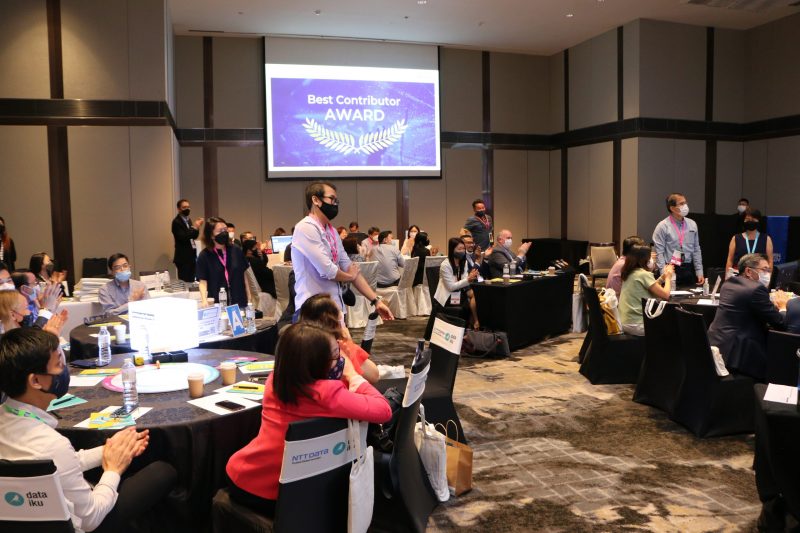 Delegates were then asked about what would have the bulk of their budget allocation in 2022 –2023. Just under a third (31%) indicated that the bulk of their budget allocation would go to enhancing or adopting AI and Analytics for improving outcomes through forecasting, prediction and optimisation. Other delegates were split between digitalisation of processes to deliver better or ‘Smart’ services (21%) and data-driven initiatives such as Big Data/Data Lake (21%). The remaining selected improving integrity and governance whilst reducing inefficiency (14%), embracing cloud technology, be it public or private (10%), leveraging IoT to improve processes and productivity (3%)
Delegates were then asked about what would have the bulk of their budget allocation in 2022 –2023. Just under a third (31%) indicated that the bulk of their budget allocation would go to enhancing or adopting AI and Analytics for improving outcomes through forecasting, prediction and optimisation. Other delegates were split between digitalisation of processes to deliver better or ‘Smart’ services (21%) and data-driven initiatives such as Big Data/Data Lake (21%). The remaining selected improving integrity and governance whilst reducing inefficiency (14%), embracing cloud technology, be it public or private (10%), leveraging IoT to improve processes and productivity (3%)
Inquiring about the main challenge in their data strategy journey, most (41%) found the lack of data culture/literacy/skill across employees challenging. The other remaining delegates selected missing an overall strategy that crosses departments and teams (36%) and data governance, data privacy and security concerns (23%).
On the key concern in the consideration to move to cloud, just over half (52%) were concerned about security and governance. The other delegates felt the need to re-skill talent (18%), operational costs (18%) and vendor lock-in (12%) would be the most pressing.
The subsequent poll asked delegates what they saw as the biggest challenge in digitalisation and cloud migration. Most of the delegates (41%) found security and compliance risk the biggest challenge. It was followed by people and skillset (26%), legacy infrastructure (17%), executive support/top management strategy (17%) and budget (4%).
On their key priorities to enhance the service experience of citizens/ customers, delegates were evenly split between leveraging analytics to personalised customer interactions (35%) and improving internal collaboration across teams and agencies (35%). Other delegates identified unifying channels, tools, and customer context into a single view as the key priority (19%), followed by increasing the adoption and usage of self-service and AI-powered bots (8%) or implementing messaging as part of their communication channels (4%).
When asked about the top analytic adoption challenge in their organisation, more than half (54%) expressed that data quality and accuracy concerns were the top challenges. This as followed by the lack of talent and training (38%), tools are too complex and difficult (4%), and limited access to analytics (4%).
On their current usage of Graph Database in their department, most (46%) use it to a limited extent and are in the initial phase of exploring how graph technology can be of value. About a quarter (23%) opted for using it on a small scale or having some understanding of how graphs work. The rest were equally divided in using it in several projects but not at a production level and are familiar with graphs (15%) or use graphs at an enterprise level and are curious to find out more about scalability, distributed (advanced users/clients) (15%).
The final poll for the day asked delegates about the main motivator that is driving digital transformation. Most (44%) see a growing need to maximise value/insights from an increasing amount of data assets. Others are motivated by the desire to speed up their time-to-market to fully capitalise on business opportunities or to serve citizens better (32%), the improved capability to manage an increasing amount of data at the edge locations while ensuring security and compliance (16%), and to provide a consistent and seamless cloud-everywhere experience across a distributed organisation (8%).
Closing
In conclusion, Mohit thanked all the delegates for their wonderful presence and emphasised the criticality of digital transformation in the age of COVID-19. Staying abreast of the technologies that can enable business outcomes, adapting to shifting cultures and taking risks are necessary if organisations want to continuously innovate, achieve operational efficiency and resolve pressing issues.
















